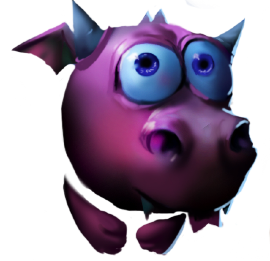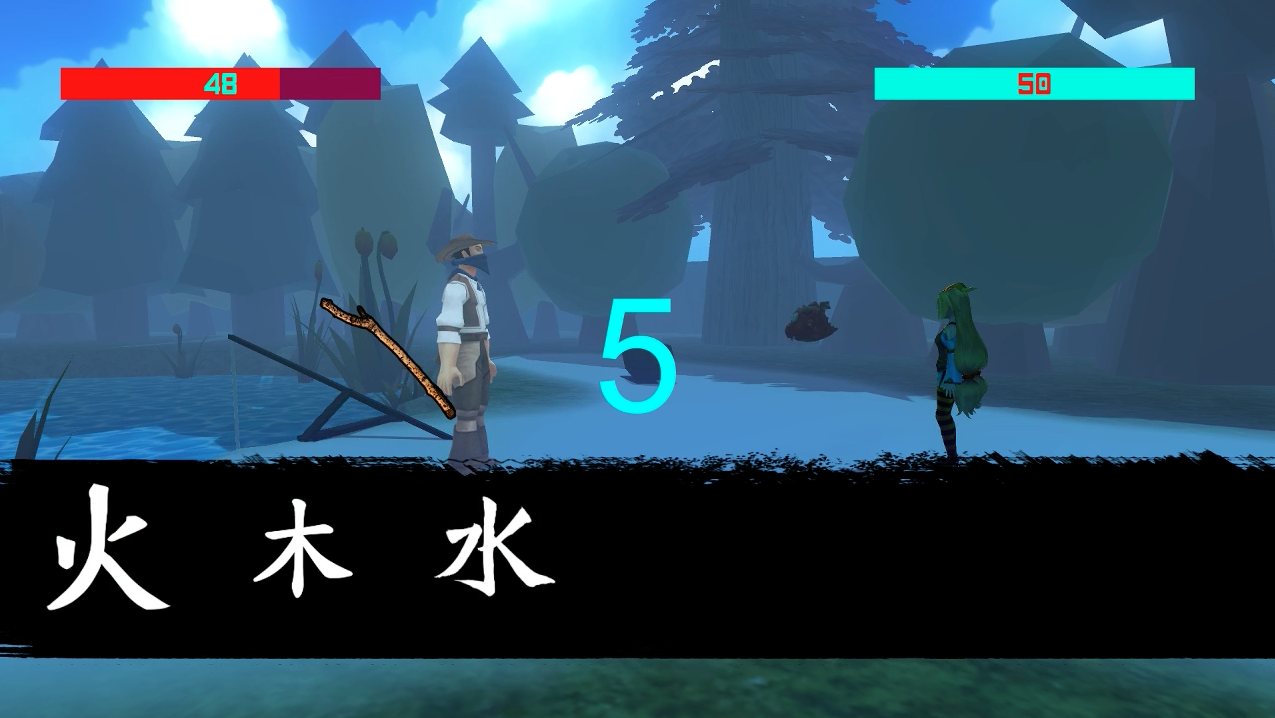Author: | Monika Wintergerst |
|---|---|
| Supervisor: | Prof. Gudrun Klinker |
| Advisor: | Andreas Dippon |
| Submission Date: | 00.00.2015 |
Abstract
Many serious games targeting language acquisition can be found recycling old-school vocabulary trainers while the actual gameplay takes a backseat. In an effort to combine both didactics and engaging interaction, we have developed a game teaching Japanese kanji - the logographic characters borrowed from Chinese - using Unity 3D. We have picked this complex scenario because learners of Japanese often struggle with kanji, as they require to memorize the meaning, the Japanese pronunciation as well as the stroke order of the character. So rather than separating learning ingredients from playing we closely interweave writing, pronunciation and understanding into the core mechanics and fighting system by using RPG elements and hand-writing recognition. All this comes together in a Pokémon-like adventure where you adopt a mythical dragon.
- Katharina Brand
- Janosch Kindl
- Stefan Kreisig
- Monika Wintergerst
Trailer first semester
Trailer second semester
Background: Kanji
Kanji are logographic characters used in the Japanese language that were imported from China. An example for a word written with kanji is 日本語, which consists of three kanji and means Japanese language. Together with the two syllabaries “hiragana” and “katakana”, kanji make up the Japanese writing system. While hiragana and katakana can be learned quite quickly, kanji usually prove to be more difficult. Learners do not only need to remember the meaning, but also the correct stroke order and one or in most cases several ways to pronounce the kanji. The stroke order is important to know, for example in order to read handwriting. Furthermore, 2000 to 3000 kanji are commonly used in the Japanese language, which makes studying kanji a challenging task. In most language courses, kanji are introduced to students and then written repeatedly in order to memorize them.
The different pronunciations of kanji are called readings. To explain this, you can think of how signs are used in English. If you have Tom + Jerry and Two + three the plus sign can have the reading and in the first case and plus in the second.
In the game, we start by introducing easy kanji with few strokes. We also put an emphasis on teaching characters that are important in everyday life, such as the numbers or kanji used to represent the days of the week.
Story
| The protagonist of our story is a young woman called Yuni who lives in a tiny village in fantasy rural Japan. One day after a terrible storm, she finds a mysterious egg. Soon, a mythical creature hatches, which turns out to be a magical dragon. This is extraordinary, as dragons have vanished centuries ago and are believed to be mere legends. The small dragon, however, is proof that dragons still exist somewhere. |
| In order to reunite the little dragon with his family, Yuni goes on an adventure to find the dragon tribe. On her journey, she will have to overcome many obstacles and defeat enemies. Luckily, her dragon friend can help her with his magical abilities. |
Game Mechanics
| As the game is played on a tablet, we had to think of a way to comfortably control the main character using touch input. If the player touches the screen in a certain area along the left fringe, a control element spawns where the touch occurs. This control functions like a joy-stick and can be used to navigate the main character through the game world. |
Mini Games
The game includes five mini games that each teach a different aspect of kanji.
Drawing Game
| The Drawing Game lets the player practice how to write a kanji. While this mainly teaches the correct writing of the character, it also helps with remembering the kanji, as repeatedly writing it makes it easier to recognize it. In the beginning, the whole kanji is shown and then fades out. After that, the kanji is automatically written once in order to show the correct stroke order to the player. The so drawn kanji fades out again until it is half transparent. Then, it is the player's turn to draw the kanji in the correct stroke order. Players can simply draw with their fingers on the tablet. It is important to draw the strokes in the correct order, as well as in the correct direction, for example from left to right. Also, the drawing needs to follow the strokes of the underlying kanji precisely enough to be deemed correct. If a stroke was not drawn correctly, the next correct stroke will be once again shown to the player. |
Puzzle Game
| The aim of the Puzzle Game is to associate a kanji with the correct meaning. It could be enhanced in the future to also assess the knowledge of the correct pronunciation. Initially, the player sees six kanji, and a picture with a word describing the meaning of the searched kanji fades in. The player selects the fitting kanji by tapping it. If the answer was correct, the kanji is highlighted in green and disappears together with the image. If the answer was wrong, the kanji is highlighted in red, and the correct kanji is highlighted in green. Both kanji will disappear with the image. Then, the next image is presented to the player, and this continues until there is only one kanji left. Players are rated on their performance and are forced to retake the quiz when they have scored too low. Also, if a player does not associate a picture with the correct kanji, this pair will appear more often, whereas kanji that the player has proven to know well will not appear so often. |
Battle System
| The battle system is turn-based, so the two opponents take turns in attacking. When the enemy attacks, players furthermore get a chance to defend themselves. In order to attack, the player selects a kanji from the dictionary and then draws it like in the Drawing Game presented below. On completing this task, the dragon will respond to the kanji and attack the opponent with a corresponding attack. For example, on selecting and drawing the kanji for fire, the dragon will start a fire attack. When the enemy strikes back, players are informed about this and also receive a hint on what kind of attack will be used in form of text. Then, they have the opportunity to defend themselves. To do this, they have to select a kanji from the dictionary. This time, writing the kanji is not necessary. However, their time to choose the correct kanji for defense is restricted, which is indicated by a countdown on the screen. There are different classes of opponents and different classes of attacks. Different attacks vary in their effectiveness against enemies of a certain class. For instance, using a fire attack against a fire class enemy is not effective, while using water against this enemy will be very effective. Players need to observe their opponents and their reactions to attacks in order to find their weak spot. To exploit an enemies weakness, players also need to know the meaning of the kanji they use as an attack. This means the fights in the game serve to test the players' knowledge of both the meaning and writing of kanji. |
Reading Game
| The Reading Game is a kind of battle system which aims at teaching the pronunciation of kanji. Even though the player has to face several opponents in the fight, each enemy is fought against sequentially in round-based combat. The player has to select the correct syllables and put them into presented slots via drag and drop. These transparent slots in the center of the screen show the player how many syllables the searched word has. When a player puts the correct syllable in the correct slot, it turns green and the enemy is attacked. When the player puts a wrong syllable in a slot, it will turn red. The opponent then attacks the player, playing an attack animation and decreasing the player’s health. When one enemy has been defeated, the camera focuses on the next opponent with a new kanji above his head. This continues until all enemies are defeated or the player lost the fight. This happens when the player’s health bar is empty, meaning the player has made too many mistakes. |
Compound Game
| The Compound Game is a puzzle game which teaches the player compound words. Compounds are words consisting of more than one kanji. In the beginning, the player is instructed to form a specific compound word, and can then experiment with different kanji in order to solve this task. The Compound Game employs augmented reality by using Vuforia. The player can rearrange markers on the table. By looking at markers in the real world, the kanji can be seen. Looking at the marker by using the camera, a 3D object or an image depicting the meaning of the corresponding kanji appears on the marker. Some markers are connected with lines, which indicates that these kanji can be combined to form a compound word. Red lines signal that the order of the kanji is still incorrect. Green lines signal a correct order of kanji. When markers of kanji that can form a valid compound word are put next to each other in the correct order, the 3D models or images depicting the meaning of the single kanji disappear. Instead, there will be one model or image for the compound word, which shows the compound’s meaning. The game ends once the player has formed the compound which corresponds to the task. |
User Feedback
We conducted a small user study to receive feedback on Dragon Tale. We also set up a short test to find out whether our game was able to convey knowledge about kanji.
All in all, the feedback was positive. The participants mostly enjoyed the gameplay and thought the game was useful for learning about kanji. Our kanji test also indicated that players were able to learn something while playing the game.
Possible Future Work
The project is finished after two semesters. While the basic concepts of the game have been implemented, there are still many things that can or should be added in order to enhance the gaming experience as well as the learning experience. Some of these are:
- Radicals: Radicals are the elements that make up kanji. They often give hints about the kanji's meaning or pronunciation and are used to lookup kanji in the dictionary.
- Voice Output: Unfortunately we could not find a native speaker that wanted to record some words for us.


